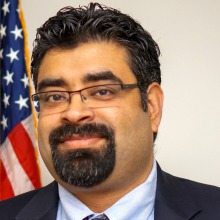
WashingtonExec 2015 Market Outlook Series
We look forward to a new year and new opportunities for innovation and growth in the government contracting community. This past year, we experienced an increased emphasis on cybersecurity, the government’s procurement process and a perpetual focus on doing more with less.
WashingtonExec reached out to those most knowledgeable and experienced in the federal contracting space. We asked executives in and around the beltway for insight regarding where they see the government contracting community headed in 2015. Topics discussed include M&A activity, cloud computing, privacy issues, data collection, healthcare IT, defense and more.
Ingenicomm Inc. President and CEO Amit Puri envisions the federal government and industry members collaborating more to benefit both partners in the long term.
WashingtonExec: What will next year hold for Government Contracting?
Amit Puri: 2015 looks to be another year of reduced government spending, particularly in the technology-focused areas of government contracting, such as IT system development and technology R&D. I’ve already seen the effect of this on both large and small programs, including some of the high-profile programs that had been able to escape previous rounds of budget cuts. As overall government expenditure in these sectors is reduced, contractors will be forced to innovate in both technology and process in order to remain profitable while continuing to meet their government customers’ needs.
There appears to be a renewed willingness to engage with industry not simply for execution of government-planned projects, but for collaborative innovation that will benefit both government and industry partners in the long term. I am hopeful that the government’s movement in this direction will allow for program costs to be reduced without adversely impacting the quality of the solutions provided, as has so often been the case before.
WashingtonExec: What future collaboration will take place between industry and government in addressing tough issues?
Amit Puri: As in previous years, I expect that budget pressures will lead to continuing collaboration on the development of heterogeneous IT solutions that seamlessly integrate off-the-shelf and contractor-developed elements with new or existing government-developed capability. Government customers will expect to play a larger role in developing and integrating these solutions than they traditionally have as they aim to lower program cost and reduce the risk of a solution that doesn’t meet their needs or won’t work out of the box.
WashingtonExec: Where do you see a potential for fusing technologies with modern business practices to better the efficiency of government?
Amit Puri: As many government agencies consolidate their legacy IT infrastructure into new enterprise-wide systems, there is tremendous potential to leverage the modern supply chain management practices that have been developed across the technology industry. We are already seeing this take place in several agencies, which are moving towards integrated configuration management and supply chain management systems that will greatly reduce the complexity and cost of system maintenance and allow seamless technology upgrades over the lifetime of the enterprise systems without requiring expensive redesigns or migration from one system to another.
WashingtonExec: What concerns you the most when looking ahead at the future of GovCon? What makes you most excited about the future of the GovCon space?
Amit Puri: Of chief concern is the continuing uncertainty with government budgets and the resulting hesitation of many agencies to commit to long-term programs – particularly those that may require extensive periods of up-front research and development to produce results, no matter how innovative those eventual results might be.
On the other hand, there appears to be a renewed willingness to engage with industry not simply for execution of government-planned projects, but for collaborative innovation that will benefit both government and industry partners in the long term. I am hopeful that the government’s movement in this direction will allow for program costs to be reduced without adversely impacting the quality of the solutions provided, as has so often been the case before.
WashingtonExec: How would you describe your business strategy during the past 3-5 years, and what is your organization’s plan for growth for next year? How has your business been able to grow as the federal market contracts?
Amit Puri: During the past five years, we’ve been remarkably successful in growing a robust and high-margin system-level product business. Our focus has been on catering to smaller government customers with unique requirements and leveraging our subject matter expertise and rapid development capabilities to deliver customized solutions without the high overhead that would be required by a larger company. This approach has enabled us to consistently increase our revenue even as the budgets of our key customers have contracted.
As we move into 2015, we are continuing to aggressively market individual products, while at the same time pursuing additional engagements in system-of-systems architecture and development as well as specialized systems engineering and integration work. Our reputation for technical expertise and commitment to our customers’ missions has led numerous agencies to approach us for assistance with larger elements of their IT infrastructure, and we are expanding to meet this demand.
Related: CIO Review Magazine Identifies 10 Most Promising Engineering Service Providers


